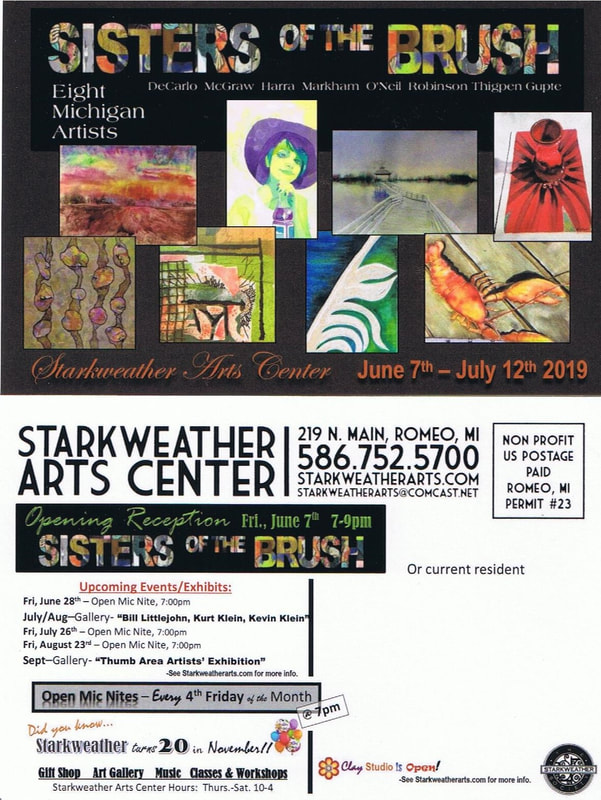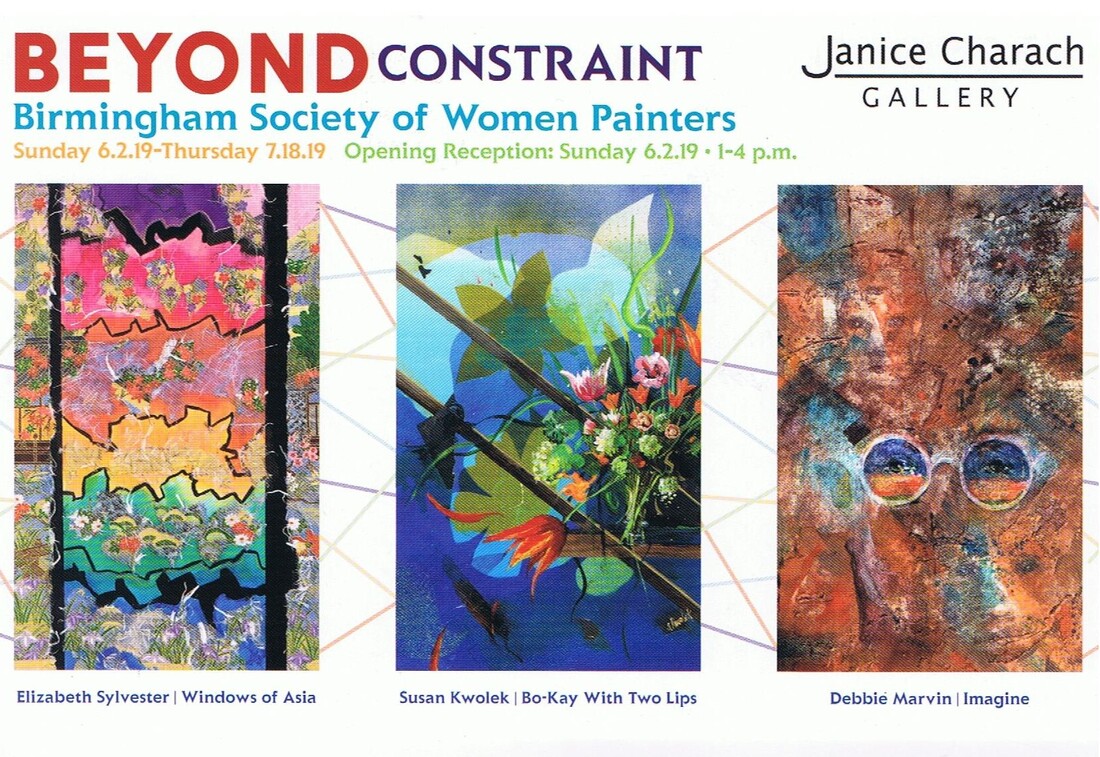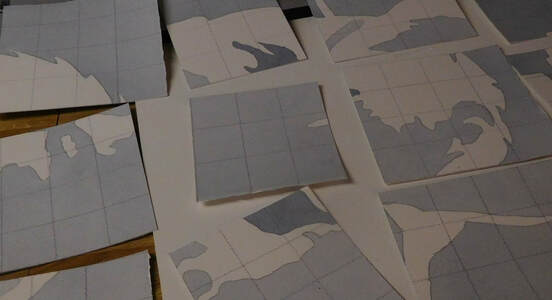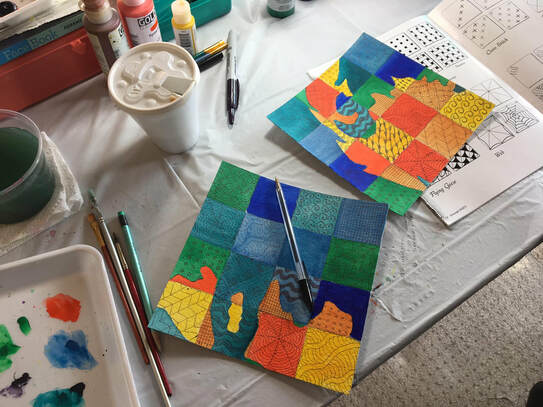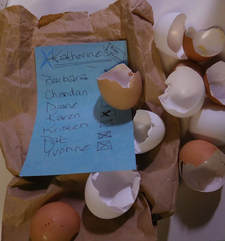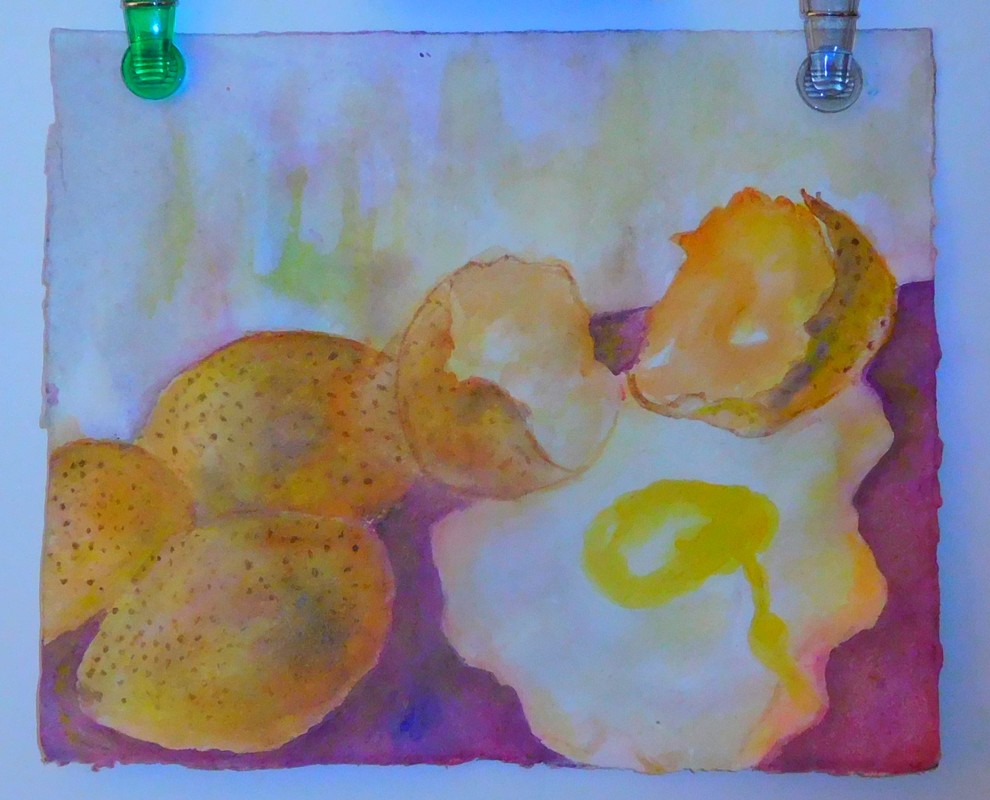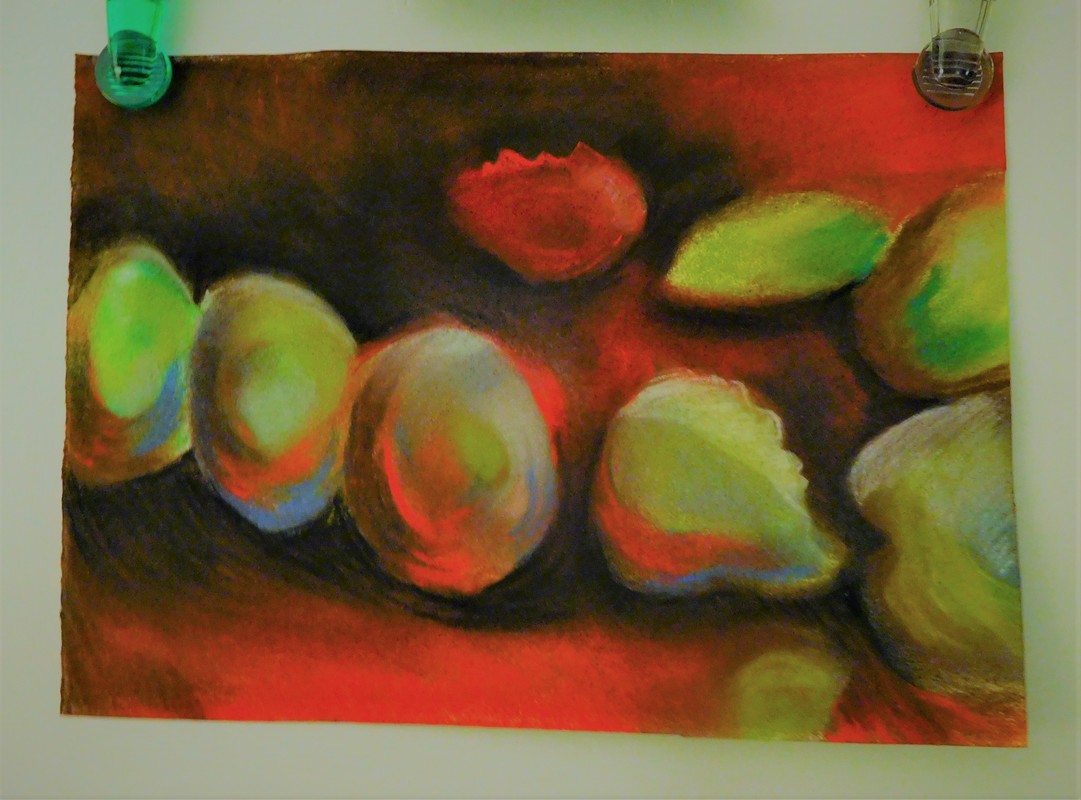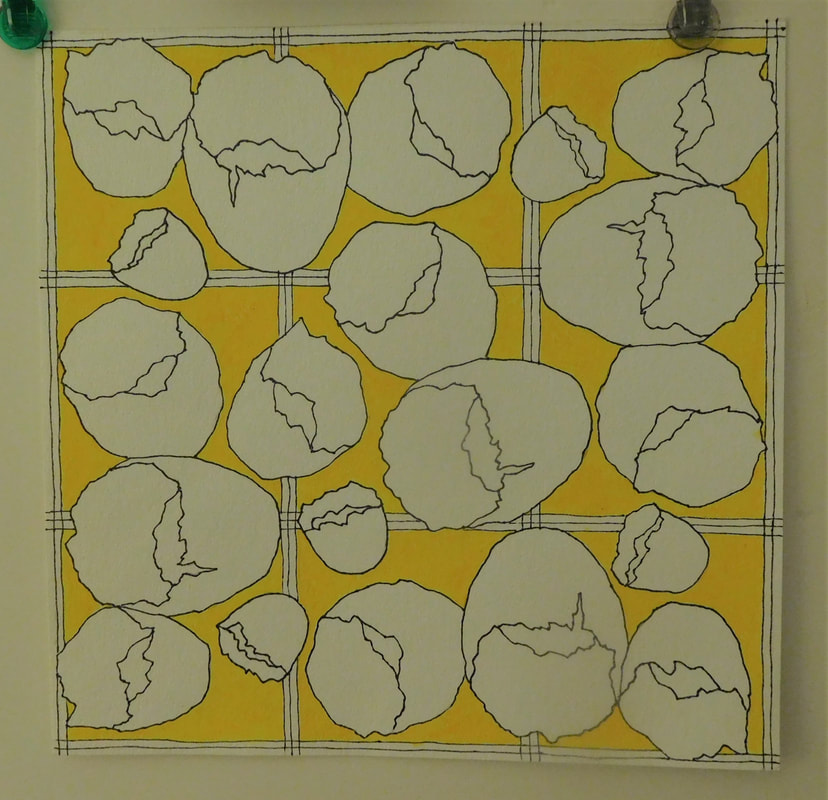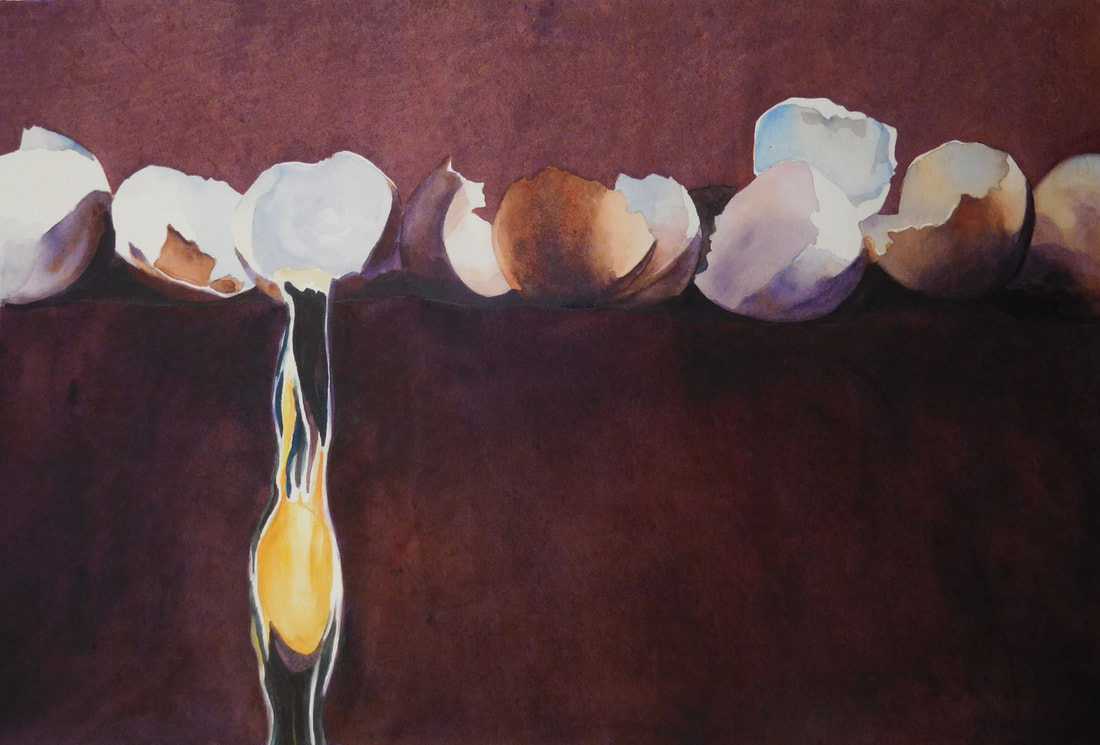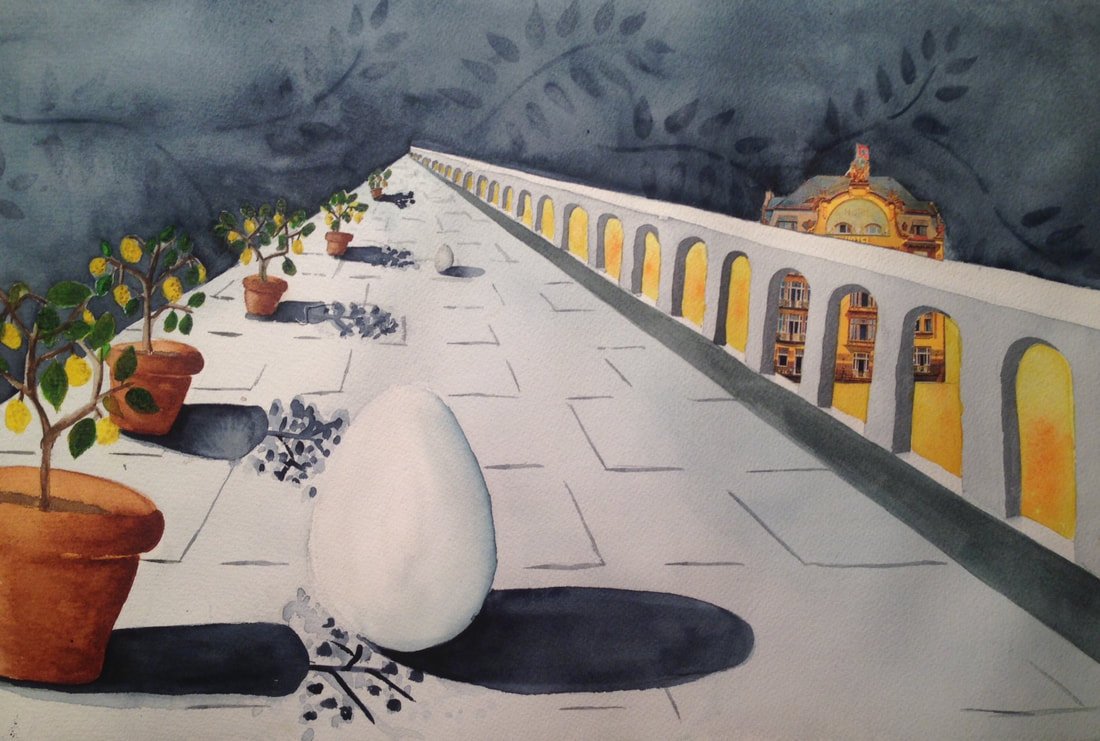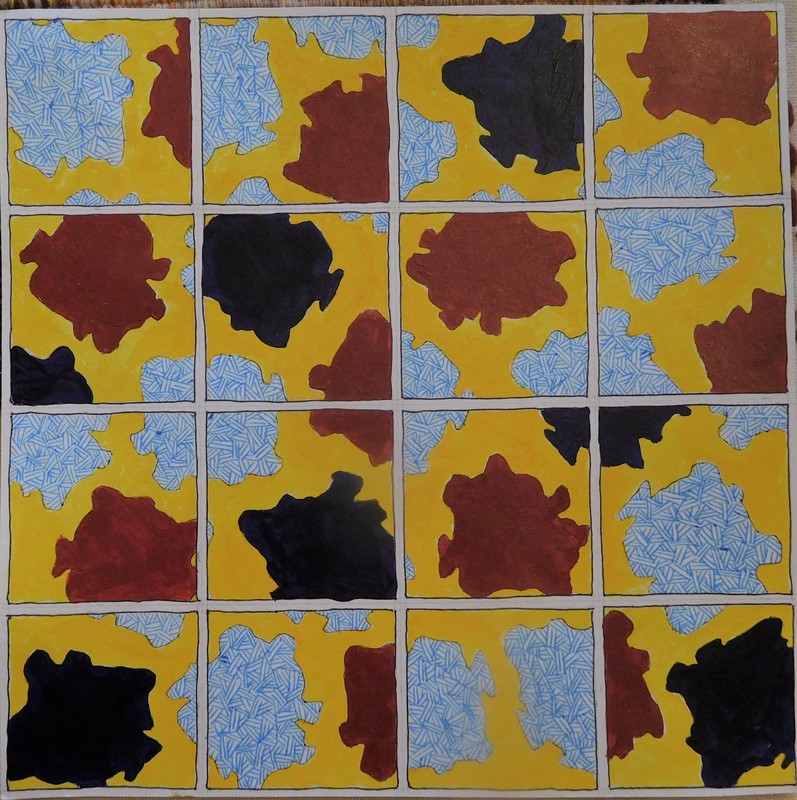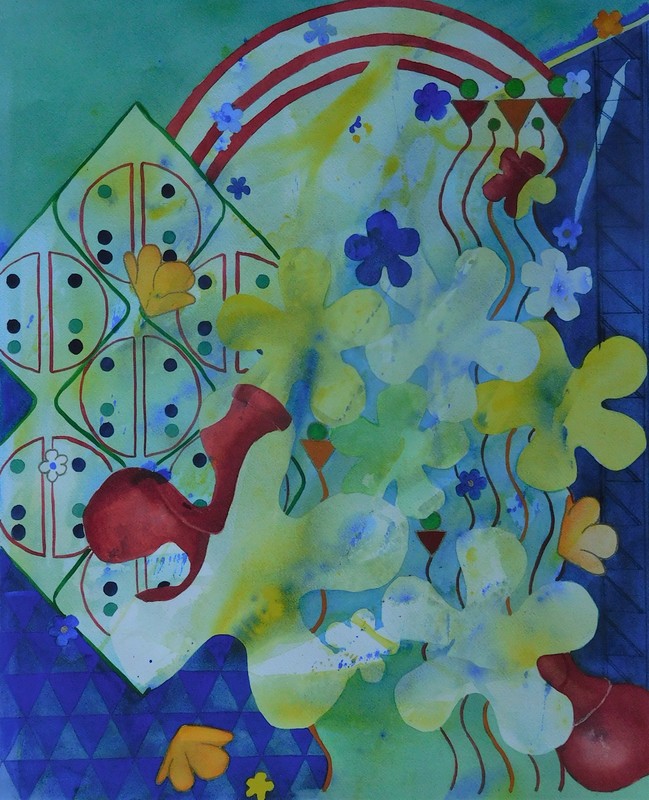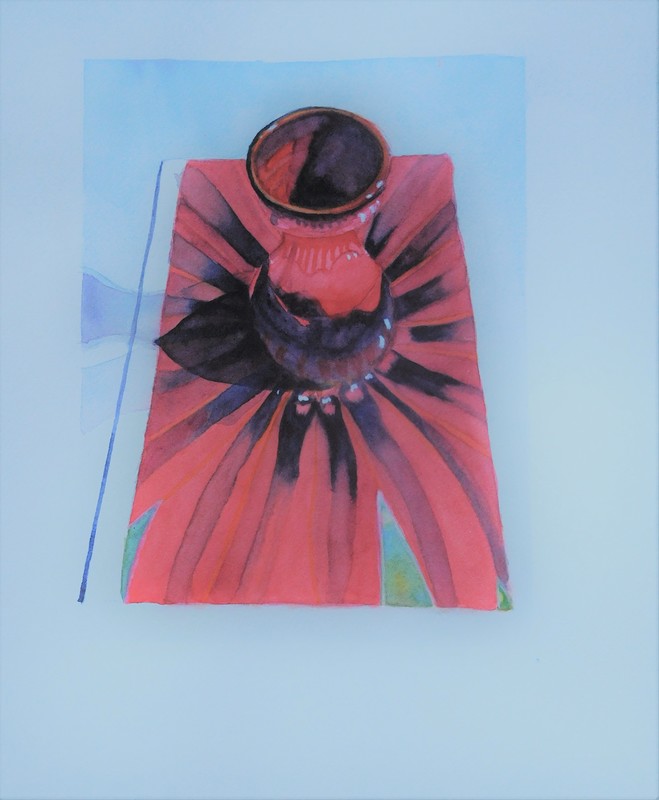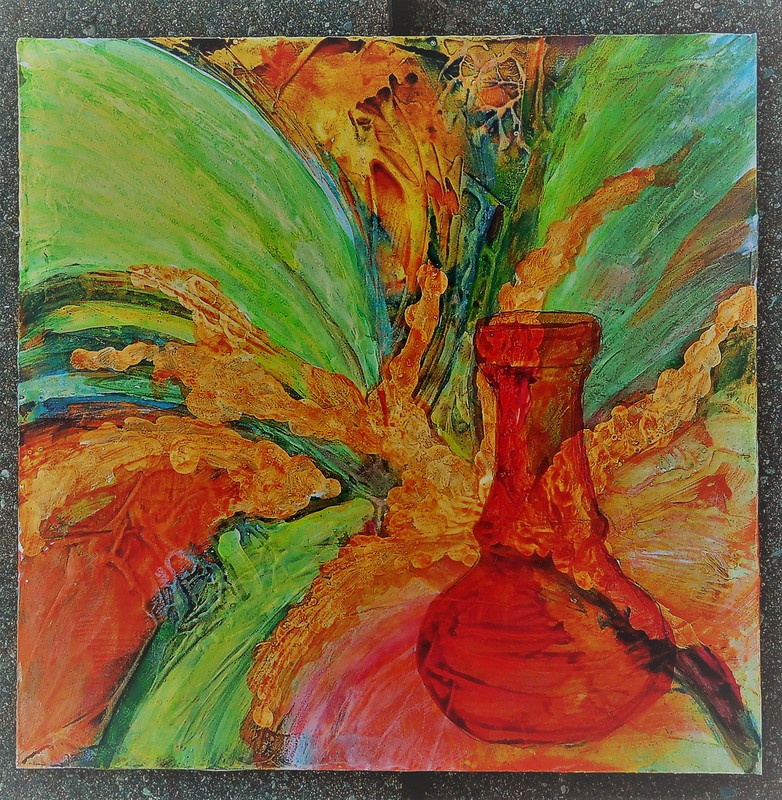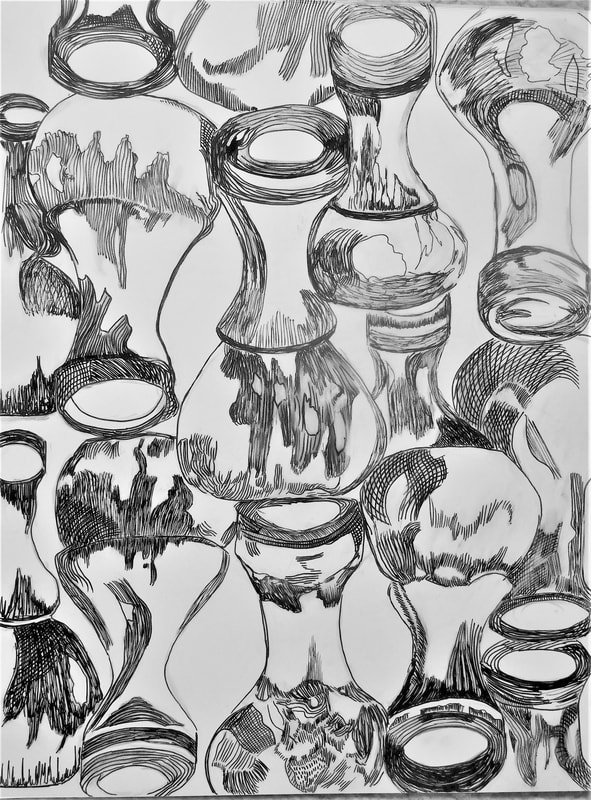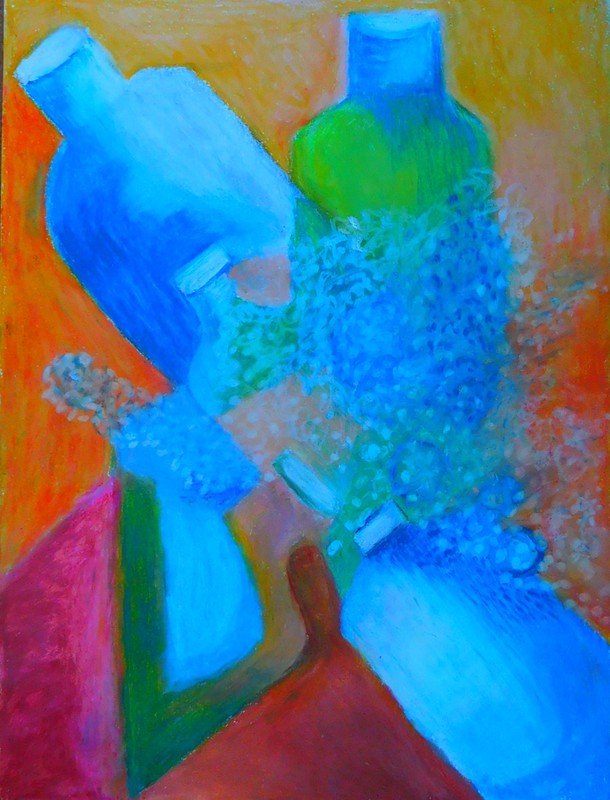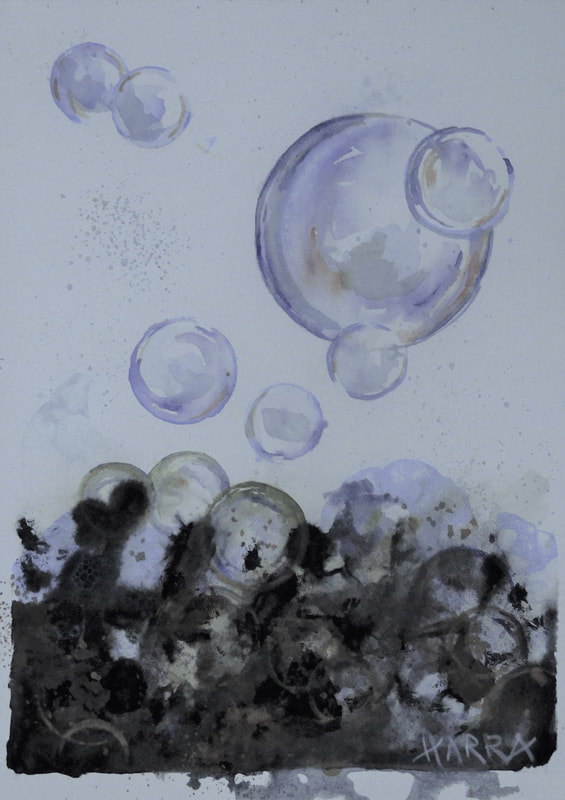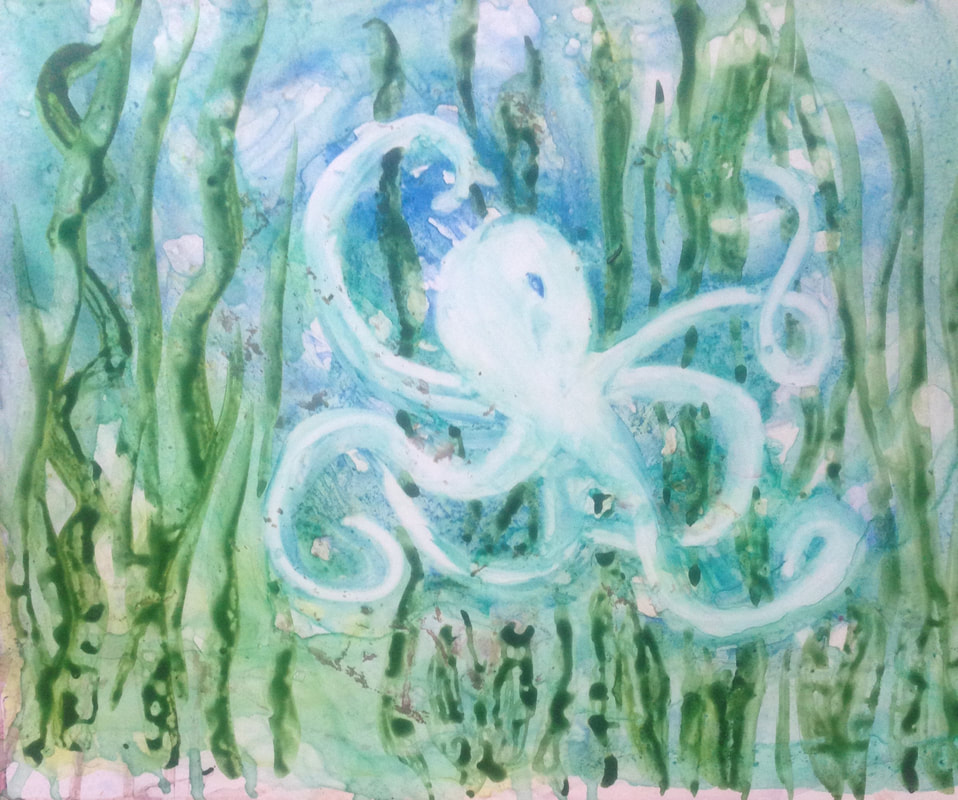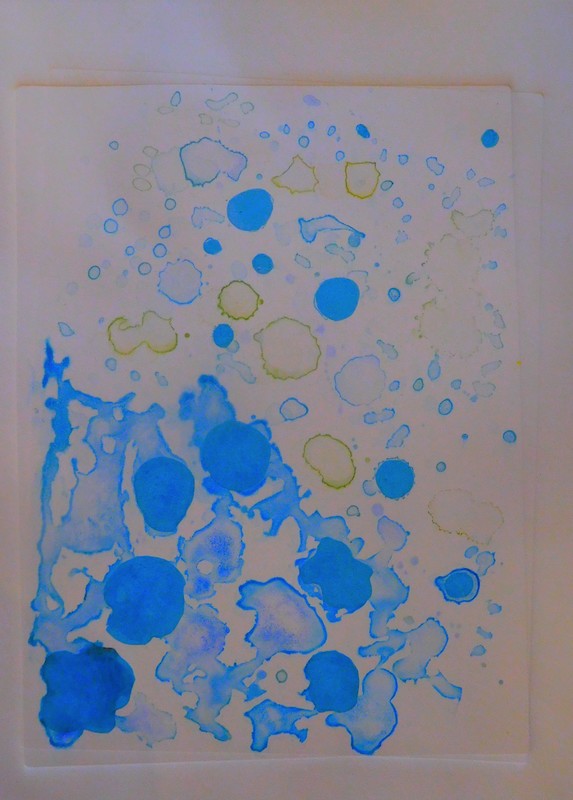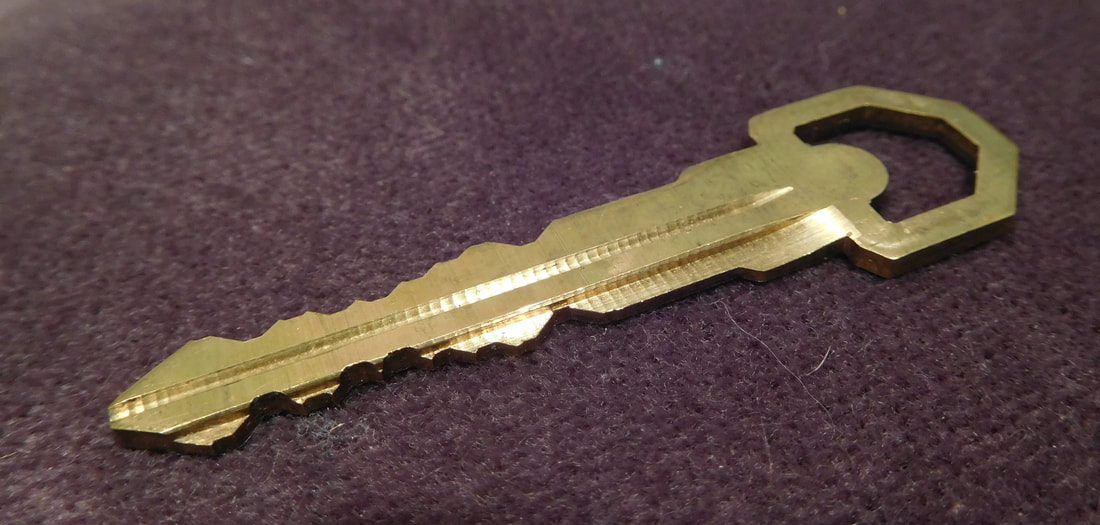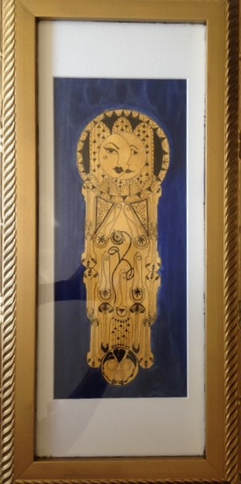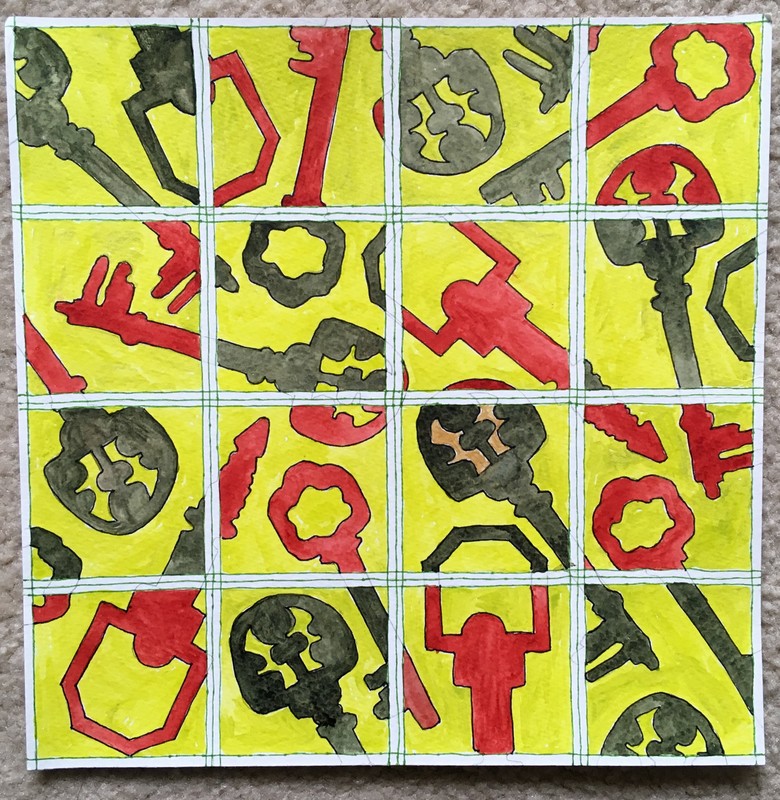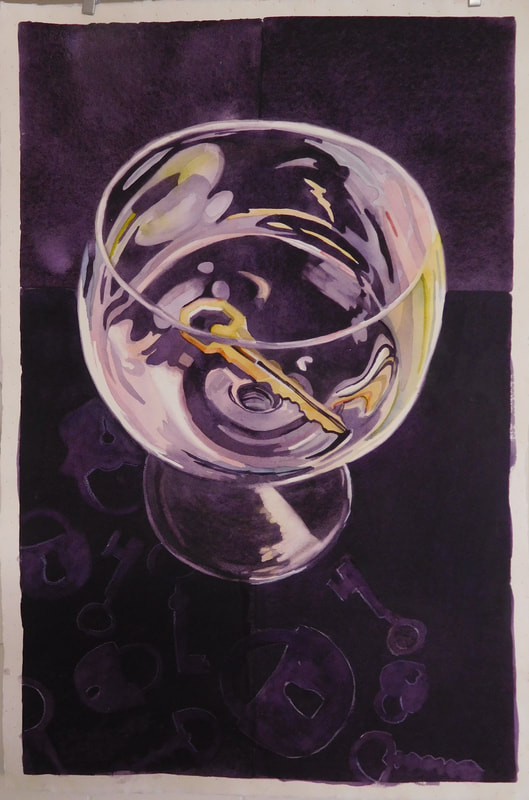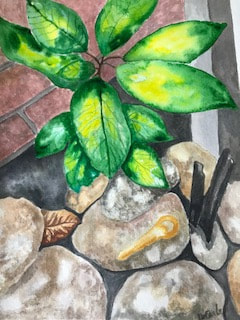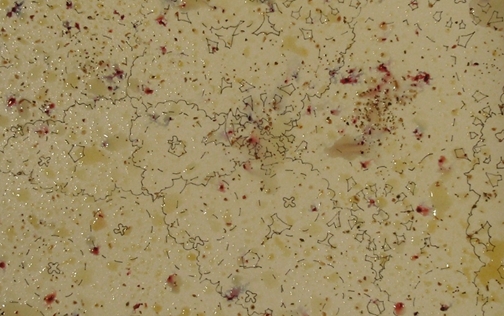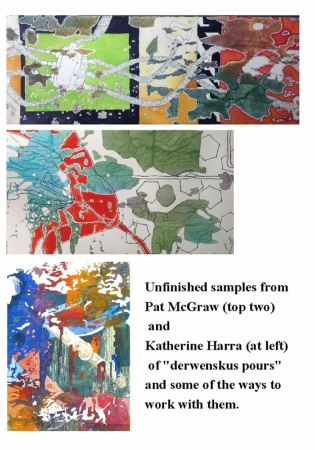|
Join us for our exhibit at Starkweather Gallery in Romeo, Michigan. Details on our postcard, at left. Included in the exhibit is the result from our "Chuck Close Collaboration", described below.
|
Also coming up this month: Katherine Harra will have artwork in the 72nd Annual Michigan Water Color Society juried exhibit in Bay City, as well as the Birmingham Society of Women Painter's exhibit, "Beyond Constraint", in West Bloomfield. Opening Receptions for both, shown on the postcards below.
|
March 2019 - Our "Chuck Close Collaboration Challenge"
Six of the eight S.O.B.s were able to gather over the recent weekend at a scrapbooking bed-n-breakfast called Memories Manor in St Clair, Michigan. Besides working on our own artwork in the amazing surroundings, we also tackled a group project. Each artist was given a couple of rectangles of 300# watercolor paper, with some gray and white shapes indicated, overlaid with squares. They looked like this:
With no idea what their result was to be, they were asked to paint the gray squares and partial squares with blues and greens, the white areas with warm oranges and yellows. Then they were to decorate each square with patterns. Now the rectangles looked like this:
See all the steps from inspiration through the Final Reveal here:
Older projects: scroll down!
Tchotchke Tchallenge - Eggshells
Tchotchke Tchallenge - Little Red Vase
I think some additional explanation is necessary by now. Tchallenge/ "Mystery Object" (page down a bit), was inspired (no one guessed! no one won the grand prize!) by a small bottle of hand sanitizer from Barbara Markham's purse! Yvonne actually used the sanitizer with her paint. Pat made hand prints with the sanitizer, then worked around them. Others were taken with the idea of cleanliness and germs - we are enjoying so much seeing how differently we are reacting to every day items.
This month? Maybe a bit more background needed? I think Diane's, Karen's, and Katherine's are self-explanatory, but Pat needed to explain to us that the most interesting thing she found about the vase was the splotch on the bottom, so she worked with that! Yvonne put her creativity to work and used THREE different Tchotcke inspirations in a single painting. I think you can find where the red vase ended up. Perhaps I will leave identifying the remaining items for later months, when the rest of our work gets revealed!
This month? Maybe a bit more background needed? I think Diane's, Karen's, and Katherine's are self-explanatory, but Pat needed to explain to us that the most interesting thing she found about the vase was the splotch on the bottom, so she worked with that! Yvonne put her creativity to work and used THREE different Tchotcke inspirations in a single painting. I think you can find where the red vase ended up. Perhaps I will leave identifying the remaining items for later months, when the rest of our work gets revealed!
The Great Tchotchke Tchallenge - Mystery Item
No, not a misprint. This month, you the viewer are tchallenged to figure out just exactly WHAT everyday item was the inspiration for these paintings. We hope you will find our Facebook Page www.facebook.com/sistersofthebrush/, to let us know what you think!
The Great Tchotchke Tchallenge - The Key
These show how five of the Sisters of the Brush responded to Diane O'Neil's Tchallenging Tchotchke, the key.
SOB Member ContributionsWatch the space below in coming months for thoughts, tips, inspirational quotes, articles, and miscellanous contributions (honestly, we don't know yet just what) from each of our members. When new items are posted, we'll move the prior ones to the bottom of this home page.
. 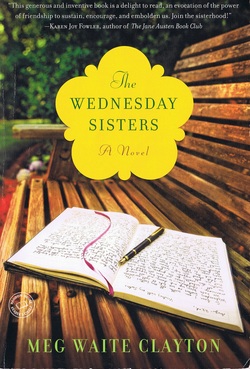
THE WEDNESDAY SISTERS
Several of our group have recently been delighted to read the book, The Wednesday Sisters. Written by Meg Waite Clayton, the book describes a small group of women who aspire to be writers, and by forming a writing and critique group, they support each others’ efforts through many years and successes. They also – and perhaps more importantly in this book - support each other as friends through life’s vicissitudes. I would expect anyone would enjoy reading this lovely book, but it has special meaning for those of us in the Sisters of the Brush - who, as luck would have it, now meet monthly on Wednesdays. How could we NOT identify with the book. It’s been at least seven years since we started our critique group. Vanity demands that I make it clear, we started the Sisters of the Brush – and named ourselves thusly – long before we’d heard of this book. The strongest parallel I found between our group and this one has been that by forming the group, by deciding to formalize it with a name, we recognized in ourselves and in each other our mutual commitment to pursuing our art. We made ourselves, declared ourselves artists. And I think that’s what it takes to have the energy and drive to keep at it, at least a bit, even when normal life has gotten in the way of productivity. We’re so glad that we have each other and that shortly we’ll be showing new artwork together again, our fourth time at Lawrence St Gallery, nearing a dozen shows overall. We hope you will be able to come by the gallery for one of the two receptions, or at least stop in during May to see our work. And please, drop us a note (see the “contact us” page) and let us know what you think. Submitted April 2014 by Katherine Harra Painting with . . . .Tea Bags!! - by Diane O'Neil
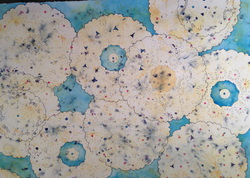
Instead of starting my painting from a blank white sheet of paper I like to start with a base. There are several techniques I use but my favorite is to use flavored teas. I wet the paper thoroughly, then sprinkle flavored teas.
I don't have a favorite kind. Usually I use a packet of tea that has been given to my husband and he doesn't want. After that I spray more water so the color starts to seep out. I have small spray bottles with watercolor paint and water in them, I use these after I see how the tea has reacted to the water. I let this dry 24 hours. Once I see what kind of pattern has been left I decide what areas I want to keep and what I will paint over. I start by drawing shapes. In this case I used a doily. I drew the doily shapes in with a Sharpie. I left some shapes out so it wouldn't be too busy. An example of what it looks like at this point is shown below. I then painted around the doilies and into the doilies until I was happy with my composition. I have used this technique with many types of paintings including portraits and abstracts. You can look at my blog http://dianeoneilart.blogspot.com/ to see more examples (or click HERE). Marilynn Derwenskus Workshop - by Pat McGraw
For three days at the beginning of June, I was once again in the energizing presence of Marilynn Derwenskus - a purple clothed teacher who can't help but share whatever she knows about current day art and artists, art history, recent gallery shows, and how to create a base - first layer - on watercolor paper before one must decide what to paint. She believes one should look at where the paint has dried after applying a layer of paper toweling and tissues saturated with watercolors and where one finds plain white empty spaces on the paper. She expects her students to now use references from photos, stencils, or any image that inspires the painter to weave them into those white spaces or on top of what is there. Often she insists upon a piece being a "narrative' or "metaphor" with a strong personal connection to the painter. I have found that I enjoy that part now and am more committed to the piece as a result. Marilynn is a retired college professor who can't stop teaching, sharing, pushing, responding, and leaving assignments unclear on purpose so we each create what we were meant to bring of ourselves onto the paper. I find my days with Marilynn tiring and full, but oh so exciting.
Also special about this workshop was that four of the Sisters of the Brush attended together: I was joined by Karen DeCarlo, Diane O'Neil, and Katherine Harra. Work from several of us can be seen below. Marilynn’s work can be seen on her web site, http://www.derwenskusart.com Tips on Drawing and Sketching from Karen DeCarlo

* Drawing and Composition are essential to a good painting - you must become a shape maker and a shape composer, to present your subject in an eye- catching way.
* Thumbnail sketches are the ticket to taking risks when you plan a painting. You can quickly and effortlessly rearrange elements and change contrast and or a color. * When deciding what to use as your source material, remember: Photographs are just pictures, sketches are a feeling. * Sketchbooks enable you to flip them open and almost always go back to where you were at that particular time. * When planning a drawing or painting, a grid drawing on your paper helps you to correctly proportion elements to your drawing surface. |
Yvonne Thigpen
|
Special Thanks
to Pat McGraw who sponsors this website as her contribution to our group.
|

